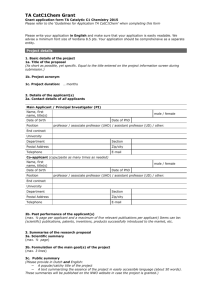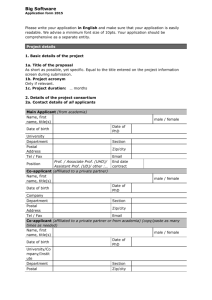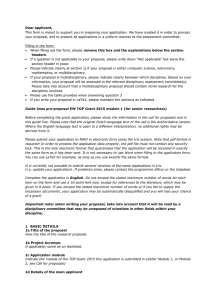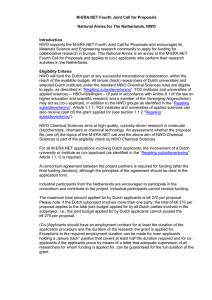A Computation of Tight Closure in Diagonal Hypersurfaces Anurag K. Singh
advertisement
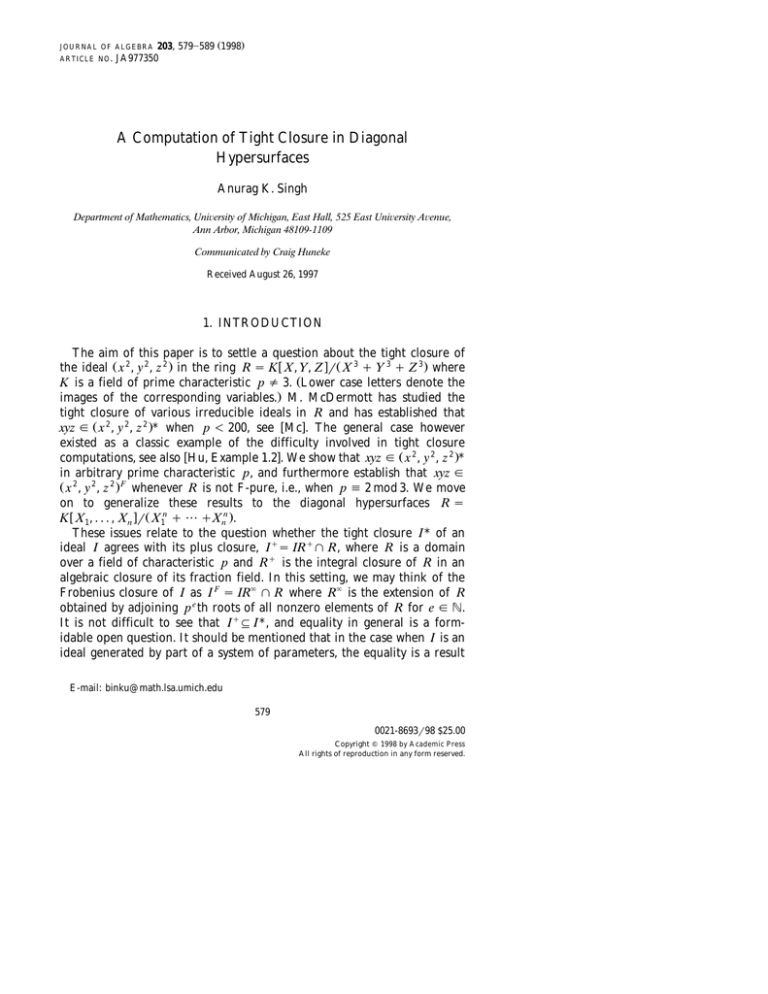
203, 579]589 Ž1998. JA977350 JOURNAL OF ALGEBRA ARTICLE NO. A Computation of Tight Closure in Diagonal Hypersurfaces Anurag K. Singh Department of Mathematics, Uni¨ ersity of Michigan, East Hall, 525 East Uni¨ ersity A¨ enue, Ann Arbor, Michigan 48109-1109 Communicated by Craig Huneke Received August 26, 1997 1. INTRODUCTION The aim of this paper is to settle a question about the tight closure of the ideal Ž x 2 , y 2 , z 2 . in the ring R s K w X, Y, Z xrŽ X 3 q Y 3 q Z 3 . where K is a field of prime characteristic p / 3. ŽLower case letters denote the images of the corresponding variables.. M. McDermott has studied the tight closure of various irreducible ideals in R and has established that xyz g Ž x 2 , y 2 , z 2 .* when p - 200, see wMcx. The general case however existed as a classic example of the difficulty involved in tight closure computations, see also wHu, Example 1.2x. We show that xyz g Ž x 2 , y 2 , z 2 .* in arbitrary prime characteristic p, and furthermore establish that xyz g Ž x 2 , y 2 , z 2 . F whenever R is not F-pure, i.e., when p ' 2 mod 3. We move on to generalize these results to the diagonal hypersurfaces R s K w X 1 , . . . , X n xrŽ X 1n q ??? qX nn .. These issues relate to the question whether the tight closure I* of an ideal I agrees with its plus closure, Iqs IRql R, where R is a domain over a field of characteristic p and Rq is the integral closure of R in an algebraic closure of its fraction field. In this setting, we may think of the Frobenius closure of I as I F s IR` l R where R` is the extension of R obtained by adjoining p e th roots of all nonzero elements of R for e g N. It is not difficult to see that Iq: I*, and equality in general is a formidable open question. It should be mentioned that in the case when I is an ideal generated by part of a system of parameters, the equality is a result E-mail: binku@math.lsa.umich.edu 579 0021-8693r98 $25.00 Copyright Q 1998 by Academic Press All rights of reproduction in any form reserved. 580 ANURAG K. SINGH of K. Smith, see wSmx. In the above ring R s K w X, Y, Z xrŽ X 3 q Y 3 q Z 3 . where K is a field of characteristic p ' 2 mod 3, if one could show that I* s I F for an ideal I, a consequence of this would be I F : Iq: I* s I F, by which Iqs I*. McDermott does show that I* s I F for large families of irreducible ideals and our result xyz g Ž x 2 , y 2 , z 2 . F , we believe, fills in an interesting remaining case. 2. DEFINITIONS Our main reference for the theory of tight closure is wHHx. We next recall some basic definitions. Let R be a Noetherian ring of characteristic p ) 0. We shall always use the letter e to denote a variable nonnegative integer, and q to denote the eth power of p, i.e., q s p e. We shall denote by F, the Frobenius endomorphism of R, and by F e, its eth iteration, i.e., F e Ž r . s r q. For an ideal I s Ž x 1 , . . . , x n . : R, we let I w q x s Ž x 1q, . . . , x nq .. Note that F e Ž I . R s I w q x, where q s p e, as always. We shall denote by R8 the complement of the union of the minimal primes of R. DEFINITION 2.1. A ring R is said to be F-pure if the Frobenius homomorphism F : M ª M m R F Ž R . is injective for all R-modules M. For an element x of R and an ideal I, we say that x g I F, the Frobenius closure of I, if there exists q s p e such that x q g I w q x. A normal domain R is F-pure if and only if for all ideals I of R, we have I F s I. We say that x g I*, the tight closure of I, if there exists c g R8 such that cx q g I w q x for all q s p e 4 0. It is easily verified that I : I F : I*. Furthermore, I* is always contained in the integral closure of I and is frequently much smaller. 3. PRELIMINARY COMPUTATIONS We record some determinant computations we shall find useful. Note that for integers n and m where m G 1, we shall use the notation ž mn / s Ž n . Ž n y 1 . ??? Ž n y m q 1 . . Ž m . Ž m y 1 . ??? Ž 1 . 581 A COMPUTATION OF TIGHT CLOSURE LEMMA 3.1. ž det ž n aqk n aqky1 / ž / ž n aqky1 n aqk ž na / ž n aq1 ??? / ??? / ž ž n a q 2k / n a q 2k y 1 / ??? ž ž n aqk / n nq1 nqk ??? aqk aqk aqk . aqk aqkq1 a q 2k ??? aqk aqk aqk ž s ??? / /ž / ž / / ž / /ž Proof. This is evaluated in wMu, p. 682x as well as wRox. Let F Ž n, a, k . denote the determinant of the matrix LEMMA 3.2. ¡ žn/ a ž M Ž n, a, k . s nq2 aq1 ž ž / n aq1 nq2 aq2 ??? / / ??? ž ž n aqk nq2 aqkq1 ??? ¢ž n q 2k aqk / ž n q 2k aqkq1 / ??? ¦ / ž n q 2k a q 2k / . /§ Then for k G 1 we ha¨ e F Ž n, a, k . s n a F Ž n q 2, a q 2, k y 1 . k k s Ž s q 2 a y n. ž / Ł Ł Ž a q r.Ž n y a q r. . ss1 rs1 Hence ž na / ž na qq 22 / ??? ž na qq 22 kk / F Ž n, a, k . s ž aqk k /ž aqkq1 a q 2k y 1 ??? ky1 1 / ž / / ž / ž 2a y n q k 2a y n q k q 1 2a y n q 2k y 1 ??? k ky1 1 ? . nyaqk nyaqky1 nyaq1 ??? k ky1 1 ž /ž ž /ž / / 582 ANURAG K. SINGH Proof. We shall perform row operations on M Ž n, a, k . in order to get zero entries in the first columns from the second row onwards, starting with the last row and moving up. More precisely, from the Ž r q 1.st row, subtract the r th row multiplied by Ž naqq2rr .rŽ naqq2rryy12 . starting with r s k, and continuing until r s 2. The Ž r q 1, s q 1.st entry of the new matrix, for r G 1, is ž n q 2r y aqrqs / s ž naqq2rr / ž n q 2r y 2 aqry1 s Ž s q 2 a y n. /ž n q 2r y 2 aqry1qs / n q 2r . Ž a q r.Ž n y a q r. a q r q s ž / We have only one nonzero entry in the first column, namely Ž na . and so we examine the matrix obtained by deleting the first row and column. Factoring out sŽ s q 2 a y n. from each column for s s 1, . . . , k and 1rŽ a q r .Ž n y a q r . from each row for r s 1, . . . , k, we see that det M Ž n, a, k . s n a k k s Ž s q 2 a y n. ž / Ł Ł Ž a q r.Ž n y a q r. ss1 rs1 =det M Ž n q 2, a q 2, k y 1 . . The required result immediately follows. LEMMA 3.3. Consider the polynomial ring T s K w A1 , . . . , A m x where Ir, i denotes the ideal Ir, i s Ž A1i , . . . , Air .T for r F m. Then a b Ž A1 ??? A ry1 . Ž A1 q ??? qA ry1 . g Iry1, aq g q Ž A1 q ??? qA ry1 . aq g T for positi¨ e integers a , b , and g implies a b q g y1 g Ir , aq g q Ž A1 q ??? qA r . Ž A1 ??? A r . Ž A1 q ??? qA r . aq g T. Proof. Consider the binomial expansion of Ž A 1 ??? A r . a Ž A 1 q ??? qA r . bq g y 1 into terms of the form Ž A 1 ??? A ry 1 . a Ž A 1 q ??? qA ry1 . bq gy1yj A ar qj. Such an element is clearly in Ir, aq g whenever 583 A COMPUTATION OF TIGHT CLOSURE j G g , and so assume g ) j. Now a b q g y1yj Ž A1 ??? A ry1 . Aar qj Ž A1 q ??? qA ry1 . g Ir , aq g q Aar qj Ž A1 q ??? qA ry1 . : Ir , aq g q Ž A1 q ??? qA ry1 , A r . : Ir , aq g q Ž A1 q ??? qA r . aq g aq2 g y1yj 2 a q2 g y1 T T T. 4. TIGHT CLOSURE We now prove the main theorem. THEOREM 4.1. Let R s K w X 1 , . . . , X n xrŽ X 1n q ??? qX nn . where n G 3 and K is a field of prime characteristic p where p ¦ n. Then ny 2 g Ž x 1ny1 , . . . , x nny1 . *. Ž x 1 ??? x n . Note that there are infinitely many e g N such that p e s q ' 1 mod n. By wHH, Lemma 8.16x, it suffices to work with powers of p of this form, and show that for all such q we have Ž x 1 ??? x n . Ž ny2 . qq1 g Ž x 1Ž ny1. q , . . . , x Žnny1. q . . Letting q s nk q 1, it suffices to show Ž x 1 ??? x n . Ž ny2 . n k g Ž x 1Ž ny1. n k , . . . , x Žnny1. n k . . Let A1 s x 1n, . . . , A n s x nn and note that A1 q ??? qA n s 0. In this notation, we aim to show Ž A1 ??? A n . Ž ny2 . k g Ž AŽ1ny1. k , . . . , AŽnny1. k . . Our task is then effectively reduced to working in the polynomial ring K w A1 , . . . , A ny1 x ( K w A1 , . . . , A n xrŽ A1 q ??? qA n . where we need to show Ž A1 ??? A ny1Ž A1 q ??? qA ny1 ..Ž ny2. k g 2 Iny1, Ž ny1. k q Ž A1 q ??? q A ny 1 .Ž ny1. k . By repeated use of Lemma 3.3, it suffices to show Ž A1 A 2 . Ž ny2 . k Ž . k Ž A1 q A 2 . g ž AŽ1ny1. k , AŽ2ny1. k , Ž A1 q A 2 . ny1 k / . We have now reduced our problem to a statement about a polynomial ring in two variables. The required result follows from the next lemma. 584 ANURAG K. SINGH LEMMA 4.2. Let K w A, B x be a polynomial ring o¨ er a field K of characteristic p ) 0 and e be a positi¨ e integer such that q s p e ' 1 mod n. If q s nk q 1, we ha¨ e Ž A, B . 2 ny3 k : I s Ž AŽ ny1. k , B Ž ny1. k , Ž A q B . Ž . Ž ny1 . k .. In particular, Ž AB .Ž ny2. k Ž A q B . k g I. Proof. Note that I contains the following elements: Ž A q B .Ž ny1. k = A B Ž ny3. k , Ž A q B .Ž ny1. kAky1 B Ž ny3. kq1 , . . . , Ž A q B .Ž ny1. k B Ž ny2. k . We take the binomial expansions of these elements and consider them modulo the ideal Ž AŽ ny1. k , B Ž ny1. k .. This shows that the following elements are in I: k žŽ žŽ n y 1. k Ž n y 1 . k AŽ ny2. k B Ž ny1. k , AŽ ny1. k B Ž ny2. k q ??? q k 2k žŽ n y 1. k Ž n y 1 . k AŽ ny2. k B Ž ny1. k . AŽ ny1. k B Ž ny2. k q ??? q 0 k / / n y 1. k AŽ ny1. k B Ž ny2. k q ??? q ky1 ??? / ž žŽ / / n y 1. k AŽ ny2. k B Ž ny1. k , 2k y 1 ž / The coefficients of AŽ ny1. k B Ž ny2. k , AŽ ny1. ky1 B Ž ny2. kq1, . . . , AŽ ny2. k B Ž ny1. k form the matrix ¡ Ž n y 1. k ž žŽ k n y 1. k ky1 / žŽ / žŽ n y 1. k kq1 n y 1. k k / / ??? ??? žŽ žŽ ??? ¢ž Ž n y 1. k 0 / ž Ž n y 1. k 1 / ??? žŽ n y 1. k 2k n y 1. k 2k y 1 ? n y 1. k k /¦ / . /§ To show that all monomials of degree Ž2 n y 3. k in A and B are in I, it suffices to show that this matrix is invertible. Since q s nk q 1 we have Ž Ž n y 1k. k q r . s Žy1. k Ž 2 k ky r . for 0 F r F k, and so by Lemma 3.1, the deter- 585 A COMPUTATION OF TIGHT CLOSURE minant of this matrix is žŽ n y 1. k k k k n y 1. k q 1 nk ??? k k kq1 2k ??? k k /žŽ ž /ž s Ž y1 . k Ž kq1 . / ž / / ž / ž /ž / ž / ž /ž / ž / 2k k k k 2k y 1 k ??? k k kq1 2k ??? k k s 1. With this we complete the proof that Ž x 1 ??? x n . ny 2 g Ž x 1ny 1 , . . . , x nny1 .*. 5. FROBENIUS CLOSURE Let R s K w X 1 , . . . , X n xrŽ X 1n q ??? qX nn . as before, where the characteristic of K is p ¦ n. LEMMA 5.1. Let R s K w X 1 , . . . , X n xrŽ X 1n q ??? qX nn . where K is a field of characteristic p. Then R is F-pure if and only if p ' 1 mod n. Proof. This is Proposition 5.21Žc. of wHRx. The main result of this section is the following theorem. THEOREM 5.2. Let R s K w X 1 , . . . , X n xrŽ X 1n q ??? qX nn . where K is a field of characteristic p. Then ny2 g Ž x 1ny1 , . . . , x nny1 . Ž x 1 ??? x n . F if and only if p k 1 mod n. One implication follows from Lemma 5.1, and so we need to consider the case p k 1 mod n. The case n s 3 seems to be the most difficult, and we handle that first. Let R s K w X, Y, Z xrŽ X 3 q Y 3 q Z 3 . where p ' 2 mod 3. We need to show that xyz g Ž x 2 , y 2 , z 2 . F . Let A s y 3, B s z 3, and so A q B s yx 3. We first show that when p s 2, we have xyz g Ž x 2 , y 2 , z 2 . F by establishing that Ž xyz . 8 g Ž x 2 , y 2 , z 2 .w8x. Note that is suffices to show that Ž xyz . 6 g Ž x 15 , y 15, z 15 ., or in other words that Ž AB Ž A q B .. 2 g Ž A5, B 5, Ž A q B . 5 ., but this is easily seen to be true. 586 ANURAG K. SINGH We may now assume p s 6 m q 5 where m G 0. We shall show that in this case Ž xyz . p g Ž x 2 , y 2 , z 2 .w px, i.e., that Ž xyz . 6 mq5 g Ž x 12 mq10 , y 12 mq10 , z 12 mq10 . . Note that to establish this, it suffices to show Ž xyz . 6 mq3 g Ž x 12 mq9 , y 12 mq9 , z 12 mq9 . , i.e., that Ž ABŽ A q B .. 2 mq1 g Ž A4 mq3, B 4 mq3, Ž A q B . 4 mq3 .. LEMMA 5.3. Let K w A, B x be a polynomial ring o¨ er a field K of characteristic p s 6 m q 5 where m G 0. Then we ha¨ e Ž AB Ž A q B . . 2 mq1 g I s Ž A4 mq3 , B 4 mq3 , Ž A q B . 4 mq3 .. Proof. To show that Ž ABŽ A q B .. 2 mq1 g I, we shall show that the following terms grouped together symmetrically from its binomial expansion, f 1 s Ž AB . 3 mq1 3m Ž A q B . , f 3 s Ž AB . Ž A3 q B 3 . , . . . , f 2 mq1 s Ž AB . 2 mq1 Ž A2 mq1 q B 2 mq1 . , are all in the ideal I. Note that I contains the elements Ž AB . m Ž A q B . 4 mq3 , Ž AB . my 1 Ž A q B . 4 mq5, . . . , Ž AB .Ž A q B . 6 mq1, Ž A q B . 6 mq3. We consider the binomial expansions of these elements modulo Ž A4 mq3, B 4 mq3 ., and get the following elements in I: ž ž ž 4m q 3 4m q 3 4m q 3 f q f q ??? q f , 2m q 2 1 2m q 3 3 3m q 2 2 mq1 / / ž ž / / ž ž / / 4m q 5 4m q 5 4m q 5 f q f q ??? q f , 2m q 3 1 2m q 4 3 3m q 3 2 mq1 ??? 6m q 3 6m q 3 6m q 3 f q f q ??? q f . 3m q 2 1 3m q 3 3 4 m q 2 2 mq1 / ž / ž / 587 A COMPUTATION OF TIGHT CLOSURE The coefficients of f 1 , f 3 , . . . , f 2 mq1 arising from these terms form the matrix ¡ 4m q 3 ž ž 2m q 2 ¢ž 6m q 3 3m q 2 4m q 5 2m q 3 / ž / ž 4m q 3 2m q 3 4m q 5 2m q 4 / / ??? ??? ž ž 4m q 5 3m q 3 /¦ / ž 6m q 3 4m q 2 /§ 4m q 3 3m q 2 ??? / ž 6m q 3 3m q 3 / ??? . We need to show that this matrix is invertible, but in the notation of Lemma 3.2, its determinant is F Ž4 m q 3, 2 m q 2, m. and is easily seen to be nonzero. The above lemma completes the case n s 3. We may now assume n G 4 and p s nk q d for 2 F d F n y 1. If k s 0, i.e., 2 F p F n y 1, we have Ž x 1 ??? x n . Ž ny2 . p s y Ž x 1 ??? x ny1 . Ž ny2 . p n x nŽ ny2. pyn Ž x 1n q ??? qx ny1 . Ž ny1. p g Ž x 1Ž ny1. p , . . . , x ny1 .. In the remaining case, we have n G 4 and k G 1. To prove that Ž x 1 ??? x n . ny 2 g Ž x 1ny 1, . . . , x nny1 . F , we shall show Ž x 1 ??? x n . Ž ny2 . p g Ž x 1Ž ny1. p , . . . , x nŽ ny1. p . . This would follow if we could show Ž x 1 ??? x n . Ž ny2 . n k g Ž x 1Ž ny1. n kqn , . . . , x nŽ ny1. n kqn . . As before, let A1 s x 1n, . . . , A n s x nn. It suffices to show that Ž A1 ??? A n . Ž ny2 . k g Ž AŽ1ny1. kq1 , . . . , AŽnny1. kq1 . . By Lemma 3.3, this reduces to showing Ž A1 A 2 . Ž ny2 . k k Ž A1 q A 2 . g I s AŽ1ny1. kq1 , AŽ2ny1. kq1 , Ž A1 q A 2 . ž Ž ny1 . kq1 /. The only remaining ingredient is the following lemma. LEMMA 5.4. Let K w A, B x be a polynomial ring o¨ er a field K of characteristic p ) 0 where p s nk q d and where n G 4, k G 1, and 2 F d F n y 1. 588 ANURAG K. SINGH Then Ž A, B . 2 ny3 k : I s Ž AŽ ny1. kq1 , B Ž ny1. kq1 , Ž A q B . Ž . Ž ny1 . kq1 .. In particular, Ž AB .Ž ny2. k Ž A q B . k g I. Proof. Note that I contains the elements Ž A q B .Ž ny1. kq1Ak B Ž ny3. ky1 , Ž A q B .Ž ny1. kq1A ky1 B Ž ny3. k , . . . , Ž A q B .Ž ny1. kq1 B Ž ny2. ky1. We take the binomial expansions of these elements and consider them modulo the ideal Ž AŽ ny1. kq1, B Ž ny1. kq1 .. This shows that the following elements are in I: žŽ žŽ žŽ n y 1. k q 1 Ž n y 1 . k q 1 AŽ ny2. k B Ž ny1. k , AŽ ny1. k B Ž ny2. k q ??? q kq1 2k q 1 / / n y 1. k q 1 AŽ ny1. k B Ž ny2. k q ??? q k ??? ž žŽ / / n y 1. k q 1 AŽ ny2. k B Ž ny1. k , 2k n y 1. k q 1 Ž n y 1 . k q 1 AŽ ny2. k B Ž ny1. k . AŽ ny1. k B Ž ny2. k q ??? q 1 kq1 / ž / The coefficients of AŽ ny1. k B Ž ny2. k , AŽ ny1. ky1 B Ž ny2. kq1, . . . , AŽ ny2. k B Ž ny1. k form the matrix ¡ Ž n y 1. k q 1 ž žŽ ¢ž Ž kq1 n y 1. k q 1 k n y 1. k q 1 1 / žŽ / žŽ / žŽ n y 1. k q 1 kq2 n y 1. k q 1 kq1 n y 1. k q 1 2 / / / ??? ??? ??? ??? žŽ žŽ žŽ n y 1. k q 1 2k q 1 n y 1. k q 1 2k n y 1. k q 1 kq1 /¦ / /§ . To show that all monomials of degree Ž2 n y 3. k in A and B are in I, it suffices to show that this matrix is invertible. The determinant of this matrix is žŽ n y 1. k q 1 kq1 kq1 kq1 ž n y 1. k q 2 nk q 1 ??? kq1 kq1 kq2 2k q 1 ??? kq1 kq1 /žŽ /ž / ž / ž / / which is easily seen to be nonzero since the characteristic of the field is p s nk q d where 2 F d F n y 1. A COMPUTATION OF TIGHT CLOSURE 589 Remark 5.5. It is worth noting that xyz g Ž x 2 , y 2 , z 2 .* in the ring R s K w X, Y, Z xrŽ X 3 q Y 3 q Z 3 . is, in a certain sense, unexplained. Under mild hypotheses on a ring, tight closure has a ‘‘colon-capturing’’ property: for x 1 , . . . , x n part of a system of parameters for an excellent local Žor graded. equidimensional ring A, we have Ž x 1 , . . . , x ny1 .: A x n : Ž x 1 , . . . , x ny1 .* and various instances of elements being in the tight closure of ideals are easily seen to arise from this colon-capturing property. To illustrate our point, we recall from wHo, Example 5.7x how z 2 g Ž x, y .* in the ring R above is seen to arise from colon-capturing. Consider the Segre product T s RaS where S s K wU, V x. Then the elements x¨ y yu, xu and y¨ form a system of parameters for the ring T. This ring is not Cohen]Macaulay as seen from the relation on the parameters 2 2 Ž zu . Ž z¨ . Ž x¨ y yu . s Ž z¨ . Ž xu . y Ž zu . Ž y¨ . . The colon-capturing property of tight closure shows Ž zu . Ž z¨ . g Ž xu, y¨ . :T Ž x¨ y yu . : Ž xu, y¨ . *. There is a retraction R m K S ª R under which U ¬ 1 and V ¬ 1. This gives us a retraction from T ª R which, when applied to Ž zu.Ž z¨ . g Ž xu, y¨ .*, shows z 2 g Ž x, y .* in R. REFERENCES wHHx M. Hochster and C. Huneke, Tight closure, invariant theory, and the Briançon]Skoda theorem, J. Amer. Math. Soc. 3 Ž1990., 31]116. wHox M. Hochster, Tight closure in equal characteristic, big Cohen]Macaulay algebras, and solid closure, Contemp. Math. 159 Ž1994., 173]196. wHRx M. Hochster and J. Roberts, The purity of the Frobenius and local cohomology, Ad¨ . in Math. 21 Ž1976., 117]172. wHux C. Huneke, Tight closure, parameter ideals and geometry, in ‘‘Commutative Algebra,’’ Birkhauser, Basel, in press. ¨ wMcx M. McDermott, ‘‘Tight Closure, Plus Closure and Frobenius Closure in Cubical Cones,’’ Thesis, Univ. of Michigan, 1996. wMux T. Muir, ‘‘A Treatise on the Theory of Determinants’’ Žrevised and enlarged by W. H. Metzler., Longmans, Green, New YorkrLondon, 1933. wRox P. Roberts, A computation of local cohomology, Contemp. Math. 159 Ž1994., 351]356. wSmx K. E. Smith, Tight closure of parameter ideals, In¨ ent. Math. 115 Ž1994., 41]60.
